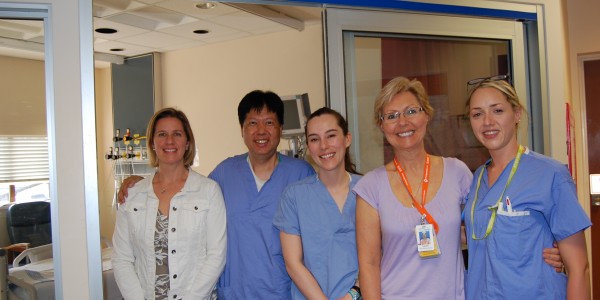Fewer Code Blues thanks to Bedmap Redesign
Over the past year, Bedmap Redesign at Richmond Hospital has resulted in impressive quality improvement gains for patients.
One of the best examples of success can be found in the hospital’s new High Acuity Unity. Created through Bedmap Redesign, the HAU, as it is known, is the place where patients who are too sick for a medical-surgical unit bed — but not sick enough for highly specialized 1:1 critical care – are placed to ensure their high-acuity needs are met.
“Our Code Blue numbers in the hospital have been reduced by half since we created the HAU and strengthened our Nurse Assessment Response (NAR) program,” said Gail Malenstyn, interim director of critical care, emergency, medicine services and patient flow at Richmond Hospital. “That’s really exciting, and proves that we can improve patient outcomes by better matching patient need with required levels of care.”
The first of its kind in the Lower Mainland, Richmond’s HAU provides care on a 1:2 or 1:3 nurse-to-patient ratio, resulting in improved monitoring and the ability to catch complications early in a patient’s recovery phase.
“There was a lot of engagement with physicians and nursing staff before changes were made to the ICU,” said Dr. Greg Haljan, a surgeon at Richmond Hospital and past- president, Medical Advisory Committee. “We broadened what we do, from ICU to HAU, to prevent critical illness by providing quicker interventions. So far, we’ve been very successful.”
Other Bedmap changes
In addition to ICU reorganization, Bedmap Redesign at Richmond Hospital has resulted in 4 Yellow Zone becoming a surgical floor and 6 Yellow Zone, a medical/surgical flex floor. While 3 Yellow Zone was previously a medicine ward, it is now known as 3 Sub Acute, specializing in geriatric psych, rehab and transitional care.
And, by May’s end, a new five-bed Short Stay Pediatric (SSP) unit, will open next to the Emergency Department, in the Red Zone. This new clinical area will allow for the placement of children in an area that best aligns with their needs, rather than mixing them in with adult patients in other areas of the hospital. Through the care quality lens, the SSP will allow pediatric nurses to provide care in the right place at the right time for VCH Richmond’s youngest patients.
Changes improve caregiver focus
According to Gail Malestyn, new units created through Bedmap Redesign mean Richmond Hospital’s clinical and nursing staff can now do the work they love in areas where their specialized skills can be best utilized.
“Patients with varied needs are no longer scattered across the hospital,” Malenstyn said. “Our new Bedmap allows staff to follow their passion and provide excellent care in areas where it can be used daily to benefit patients. Again, it’s about aligning right care, with right place, at the right time. Our new Bedmap allows for this across Richmond Hospital, and patients are benefitting.”


Pinky
Although I appreciate the meaning of the above article… unfortunately I can not help the feeling of being overworked and under appreciated in the past few years and especially since the bedmapping process started.
I know I am not alone in feeling this way. One perfect example of this -among other issues- is the new uniform policy that will begin tentatively this summer. The Hospital is spending thousands of dollars on Uniforms what we already have and that money could be spent on something much more needed… Eg. new equipment for staff to use or getting the staff back that we lost due to the bedmapping. I understand the reason behind colour coding the staff of RH, but there could be less cost effective ways to do it and without forcing everybody to wear only certain allowed uniforms at work. Eg. colour coded name tags- I am sure it would cost a lot less and staff still could keep their individual styles when it comes to the Uniforms they’re wearing at the Hospital.
Thank you for listening.